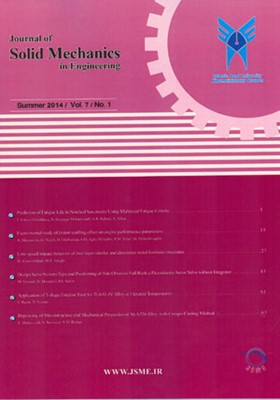بررسی رفتار سازه های فلزی دو لایه هم جنس و غیرهم جنس تحت بارگذاری ضربه سرعت پائین
Subject Areas : Journal of Simulation and Analysis of Novel Technologies in Mechanical Engineering
هادی خرّمی شاد
1
![]() ,
محمد باقری توفیقی
2
,
محمد باقری توفیقی
2
1 - استادیار، دانشکده مهندسی مکانیک، دانشگاه علم و صنعت ایران
2 - کارشناسی ارشد، دانشکده مهندسی مکانیک، دانشگاه علم و صنعت ایران
Keywords: سازه فلزی دولایه, بارگذاری ضربه ای سرعت پایین, اتصالات چسبی, تحلیل اجزاء محدود,
Abstract :
در تحقیق حاضر رفتار مکانیکی سازههای فلزی دو لایه تحت بارگذاری ضربهای سرعت پایین بصورت آزمایشگاهی و عددی مورد بررسی قرار گرفته است. آزمایشات تجربی برای اعتبارسنجی نتایج مدسازی عددی استفاده شده است. سپس با استفاده از مدلسازی عددی، رفتار سازههای متورق بطور مفصل مورد بررسی قرار گرفته است. سازههای فلزی چند لایه بسته به جنس مادی لایههای آنها تحت بارگذاری ضربهای میتوانند رفتار متفاوتی از خود نشان دهند. لایههای فلزی از چهار جنس پرکاربرد در این صنعت انتخاب شدهاند و تمامی لایهچینیهای ممکن در یک سازهی دو لایهای مورد بررسی قرار گرفته است. نتایج حاکی از آنست که در بین سازههای چندلایه با جنس لایههای یکسان، سازه فولادی بیشترین نیروی تماسی و کمترین مدت زمان تماس را دارا میباشد. درصورتیکه سازه سربی بیشترین مقدار جابجایی ماکزیمم و بیشترین مقدار انرژی اتلافی را نشان میدهد. در سازههای غیرهمجنس اگر لایهای که در مقابل ضربه قرار میگیرد از آلومینیوم 6061-T6 باشد، بیشترین نیروی تماسی زمانی اتفاق میافتد که لایهی دوم از فولاد باشد و بیشترین جابجایی زمانی اتفاق میافتد که لایهی دوم از سرب باشد. میانگین نتایج خروجی نیروی تماسی، برای سازههایی که لایهی فولادی در برابر ضربه قرار گرفته است، بیشترین مقدار را نشان میدهد. بیشترین میزان میانگین فرورفتگی نیز متعلق به سازههایی است که لایه سربی در برابر ضربه قرار گرفته است. نتایج بدست آمده در این تحقیق به طراح کمک میکند تا بهترین لایهچینی را با توجه به هدف طراحی تعیین کند. نتایج مدلسازی اجزای محدود با نتایج آزمایشگاهی و همچنین نتایج دیگر محققین قرابت خوبی داشتهاند
1] Alic J.A., Stable crack growth in adhesively bonded aluminum alloy laminates, International Journal of Fracture, Vol. 11, No. 4, 1975, pp. 701-704.
[2] Johnson W.S., Stratton J.M., Effective remote stresses and stress intensity factors for an adhesive bonded multi-ply laminate, Engineering Fracture Mechanics, Vol. 9, No. 2, 1977, pp. 411-421.
[3] Marouf B.T., Bagheri R., Mahmudi R., Role of interfacial fracture energy and laminate architecture on impact performance of aluminum laminates, Composites Part A: Applied Science and Manufacturing, Vol. 39, No. 11, 2008, pp. 1685-1693.
[4] Crouch I., Adhesively-bonded Aluminium Laminates - Their Future as Energy-absorbing, Structural Materials, in Conference on New Materials and Processes for Mechanical Design (1988 : Brisbane, Qld.), Barton, ACT, 1988, pp. 21-26.
[5] Yildirim M., Apalak M.K., Transverse Low-Speed Impact Behavior of Adhesively Bonded Similar and Dissimilar Clamped Plates, Journal of Adhesion Science and Technology, Vol. 25, No. 1-3, 2011, pp. 69-91.
[6] Apalak M.K., Yildirim M., Effect of Adhesive Thickness on Transverse Low-Speed Impact Behavior of Adhesively Bonded Similar and Dissimilar Clamped Plates, Journal of Adhesion Science and Technology, Vol. 25, No. 19, 2011, pp. 2587-2613.
[7] Pacchione M., Hombergsmeier E., Hybrid Metal Laminates for Low Weight Fuselage Structures, in: S. Pantelakis, C. Rodopoulos, Engineering Against Fracture, 2009, pp. 41-57.
[8] Sinke J., Johansson S.A.H., Fatigue and Damage Tolerance Aspects of Metal Laminates, in: M. J. Bos, Bridging the Gap between Theory and Operational Practice, 2009, pp. 585-599.
[9] Tekyeh-Marouf B., Bagheri R., Fracture behavior of multi-layered composites under impact loading, Materials Science and Engineering, Vol. 448, No. 1, 2007, pp. 20-24.
[10] Katnam K.B., Crocombe A.D., Khoramishad H., Ashcroft I.A., The Static Failure of Adhesively Bonded Metal Laminate Structures: A Cohesive Zone Approach, Journal of Adhesion Science and Technology, Vol. 25, No. 10, 2011, pp. 1131-1157.
[11] Katnam K.B., Crocombe A.D., Sugiman S.,Khoramishad H., Ashcroft I.A., Static and Fatigue Failures of Adhesively Bonded Laminate Joints in Moist Environments, International Journal of Damage Mechanics, 2011.
[12] Qiao P., Yang M., Bobaru F., Impact Mechanics and High-Energy Absorbing Materials: Review, Journal of Aerospace Engineering, Vol. 21, No. 4, 2008, pp. 235-248.
[13] Khorshidi K., Elasto-Plastic Response of Impacted Moderatly Thick Rectangular Plates with Different Boundary Conditions, Procedia Engineering, Vol. 10, No. 0, 2011, pp. 1742-1747.
[14] Lu G., Yu T., Energy Absorption of Structures and Materials, Woodhead Publishing Limited, 2003, pp. 58-59.
[15] Quesada A., Gauchia A., Alvarez Caldas C., San Roman J.L., Influence of the Parameters of the Material Model in Finite Element Simulation of Sheet Metal Stamping, in 7th EUROMECH Solid Mechanics Conference, Lisbon, Portugal, 2009.
[16] Buchar J., Rolc S., Voldrich J., Lazar M., Starek M., The Development of the Glass Laminates Resistant to the Small Arms Fire, 19th International Symposium of Ballistics, Interlaken, Switzerland, 2001.
[17] Raviraj S., Laxmikant K., Pai R., Rao S.S., Finite Element Modeling of Stress Distribution in the Cutting Path in Machining of Discontinuously Reinforced Aluminum Composites, ARPN Journal of Engineering and Applied Sciences, Vol. 3, No. 4, 2008, pp. 25-31.
[18] Rincon L.F.T., Analysis and Performance of Adhesively Bonded Crush Tube Structures, University of Waterloo, 2012.
[19] Goda Y., Sawa T., Study on the Effect of Strain Rate of Adhesive Material on the Stress State in Adhesive Joints, The Journal of Adhesion, Vol. 87, 2011, pp. 766-779.


